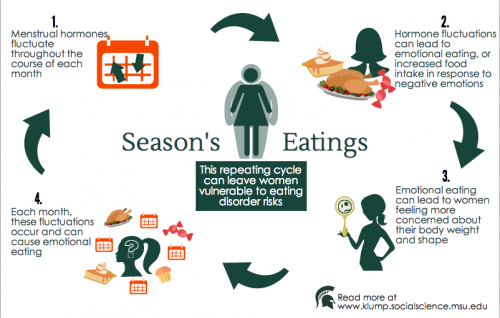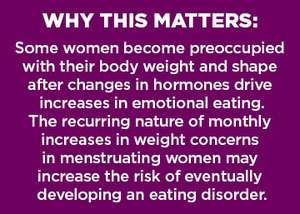Changes in food intake are all part of a natural, evolutionary process for women. MSU research has found, however, that this repeating monthly cycle can increase the risk of developing an eating disorder. Credit: MSUToday
'Tis the season of plenty of food and drink. While celebrating should be joyful, for some women, it's not. All the holiday temptations can add another layer to an already complicated biological process.
It's well known that women undergo hormonal changes every month due to the menstrual cycle. These changes can cause women to eat more, which is a natural, biological occurrence.
However, Michigan State University Foundation Professor Kelly Klump has found that the increased food intake causes some women to become much more preoccupied with their body weight and shape. This intensified obsession can increase the risk of developing eating disorder symptoms.
But the crux of the matter is that women are biologically wired to increase their food intake during their monthly cycle in preparation for pregnancy - it's supposed to happen.
Klump said the changes in food intake are all part of a natural, evolutionary process. Each month, the female body undergoes a menstrual cycle marked by changes in the hormones estrogen and progesterone. Monthly fluctuations in hormones cause women to increase the amount of food they eat and also causes emotional eating, which is the tendency to over consume food in response to negative emotions.
"In our culture, we tend to view any increased eating by a woman as a negative thing, even when that gain is biologically and evolutionarily driven," Klump said. "This is a potentially dangerous chain of events that could lead to serious and life threatening eating disorders, including anorexia nervosa and bulimia nervosa. This can be especially problematic during the holidays.
In a study published in the International Journal of Eating Disorders. Klump and co-lead author Britny Hildebrandt, MSU graduate student, said future work in this area will try to determine what other factors, in addition to emotional eating, drive pathological eating disorder symptoms in women across reproductive and hormonal stages.
Journal information: International Journal of Eating Disorders
Provided by Michigan State University






















